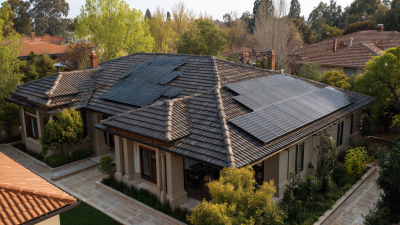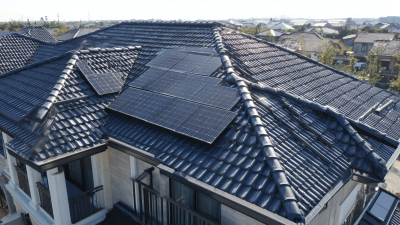Ultimate Guide to Solar PV Battery Comparisons for Global Procurement Insights
As the global demand for renewable energy solutions continues to surge, the significance of solar PV batteries in energy storage systems has never been more pronounced. According to a report by BloombergNEF, the global energy storage market is projected to exceed 1,000 GWh by 2030, with solar PV batteries playing a critical role in this transformative shift.

These batteries not only enhance the efficiency of solar energy systems by storing excess power for later use, but they also provide essential backup during peak demand periods, thereby optimizing energy consumption. With various alternatives available in the market, it is essential for stakeholders to conduct thorough comparisons to select the most suitable solar PV battery solutions for their needs.
This guide aims to provide comprehensive insights into the differing types of solar PV batteries, helping organizations navigate the complexities of global procurement while maximizing their investment in clean energy technology.
Key Factors to Consider in Solar PV Battery Comparisons
When comparing solar PV batteries for global procurement, several key factors emerge that can significantly affect the efficiency and longevity of energy storage solutions. One primary consideration is battery chemistry; lithium-ion batteries, for instance, currently dominate the market, accounting for nearly 90% of all energy storage installations due to their high energy density and longer lifespan, as reported by Wood Mackenzie. In contrast, lead-acid batteries, while less expensive, typically have a shorter lifecycle and are less efficient, making them less favorable for long-term investments.
Another critical factor is the battery’s depth of discharge (DoD) and round-trip efficiency (RTE). According to the National Renewable Energy Laboratory (NREL), higher efficiency batteries, such as lithium iron phosphate (LFP), can have an RTE of up to 95%, compared to lead-acid batteries which often fall below 80%. This efficiency translates directly into cost savings and performance enhancement over time, making it essential to evaluate these metrics when selecting a battery.
Tip: Always consider the specific energy needs and usage patterns of your application. A well-matched battery system can improve efficiency and extend the lifespan of both the batteries and the overall solar PV system. Additionally, don't overlook warranty terms and manufacturer support, as these can provide insights into the reliability and projected performance of your chosen battery.

Top 5 Solar PV Battery Technologies: Pros and Cons
When considering solar PV battery technologies, it's essential to evaluate their pros and cons to make informed procurement decisions. Lithium-ion batteries are the most popular choice, lauded for their high energy density and efficiency. They are compact and lightweight, making them ideal for residential systems. However, their higher initial cost and sensitivity to temperature fluctuations can be drawbacks that potential users must consider.
Lead-acid batteries, while older technology, offer a cost-effective solution for solar storage. They are widely available and have a proven track record in various applications. The downside is their shorter lifespan and lower energy density compared to lithium-ion options, which may lead to higher replacement costs in the long run. Another emerging technology is flow batteries, which provide scalability and long cycle life. However, they tend to have lower energy density and higher system complexity, which may deter some users.
Ultimately, each technology has its distinct advantages and limitations. By analyzing these characteristics, businesses and homeowners can make smarter choices that align with their energy needs and budget constraints. As the market evolves, staying informed about these technologies will be crucial in harnessing the full potential of solar energy.
Ultimate Guide to Solar PV Battery Comparisons for Global Procurement Insights
| Battery Technology | Energy Density (Wh/kg) | Cycle Life | Cost ($/kWh) | Pros | Cons |
|---|---|---|---|---|---|
| Lithium-ion | 150-250 | 500-2000 | 300-600 | High energy density, faster charging | Higher cost, thermal runaway risk |
| Lead-Acid | 30-50 | 300-1000 | 150-200 | Lower cost, widely available | Shorter lifespan, heavier weight |
| Flow Batteries | 20-30 | 2000+ | 400-700 | Long cycle life, scalable | Lower energy density, larger size |
| Sodium-ion | 100-150 | 300-1500 | 250-500 | Abundant materials, lower cost potential | Still under development, lower efficiency |
| Lithium Iron Phosphate (LFP) | 90-120 | 2500-7000 | 300-500 | Safe, stable, long life | Lower energy density, larger size |
Why Understanding Capacity and Efficiency Matters for Procurement
Understanding capacity and efficiency is crucial for global procurement in solar PV battery systems. As the market evolves, procurement professionals must grasp these parameters to make informed decisions that enhance performance while managing costs. Capacity refers to the amount of energy a battery can store and deliver, influencing its usability across different applications. Efficiency impacts how much of that stored energy is actually usable, with better efficiency translating to lower operational costs and improved system performance over time.
Recent analyses indicate that factors such as production costs and performance metrics are driving the industry's competitive landscape. For instance, advancements in technology are significantly influencing training costs and profit margins, especially in regions leading in manufacturing capabilities. Knowledge of these dynamics allows procurement teams to compare options methodically and select the right products that align with both operational needs and budgetary constraints, ultimately fostering a more sustainable approach to energy procurement.

Evaluating Costs vs. Performance: Making Informed Choices
When evaluating costs versus performance in solar PV battery procurement, it's essential to consider multiple factors that influence both efficiency and overall value. According to a recent report by BloombergNEF, the average cost of lithium-ion battery packs has dropped by over 80% since 2010, making them a more attractive option for consumers. However, price should not be the sole determining factor. Performance metrics such as cycle life, round-trip efficiency, and depth of discharge are crucial for assessing a battery's long-term viability. For instance, the same report indicates that leading lithium-ion batteries now achieve over 90% round-trip efficiency, significantly impacting the return on investment for solar energy systems.
Additionally, the capability of batteries to operate effectively in various conditions cannot be overlooked. Studies show that batteries with higher temperature resilience and robust safety features tend to perform better and last longer, ultimately providing greater value. A report from the National Renewable Energy Laboratory emphasizes the importance of maintenance and operational conditions in maximizing performance, suggesting that a battery with a slightly higher upfront cost but superior durability and efficiency may lead to lower lifetime costs. Thus, making informed choices based on comprehensive evaluation criteria can yield outcomes that greatly enhance both sustainability goals and financial savings in solar PV battery adoption.
Ultimate Guide to Solar PV Battery Comparisons
Sustainability and Lifespan: Why They Impact Your Procurement Decision
When it comes to solar PV battery procurement, sustainability and lifespan are vital factors that significantly influence purchasing decisions. As businesses and homeowners increasingly prioritize eco-friendly solutions, the emphasis on sustainable materials and energy efficiency in battery technology has never been greater. Sustainable batteries not only have a reduced environmental footprint during production but also promote responsible end-of-life disposal. Suppliers that focus on sustainable practices appeal to a growing market that values environmental stewardship, making them more competitive.
Lifespan is another crucial element impacting procurement choices. A battery's ability to deliver consistent performance over time is essential for both operational efficiency and financial return on investment. Batteries with a longer lifespan generally require fewer replacements, which translates to lower overall costs and reduced resource consumption. Moreover, advancements in battery technology, such as enhanced cycle life and improved energy density, enable consumers to choose products that offer durability and reliability. By prioritizing sustainability and lifespan in their procurement strategies, organizations can contribute to a greener future while maximizing the benefits of their solar PV investments.
Related Posts
-

Navigating Import and Export Certifications for the Best PV Tiles in the Global Market
-

Innovative Solutions for Harnessing Energy with Photovoltaic Tiles
-

What Makes Solar Panel Tiles a Smart Choice for Sustainable Energy Solutions
-

The Future of Sustainable Living with Solar Roof Tiles
-

15 Top Reasons to Choose Best Solar PV Roof Tiles for Sustainable Energy Solutions
-

How to Maximize Energy Efficiency with PV Tiles: Insights and Innovations in Solar Technology